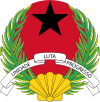Mining industry of Guinea-Bissau
Phosphate
Red Back Mining Inc. through its subsidiary Champion Industrial Minerals (CIM) held a mining lease and after completing a technical and market evaluation in 2003, the company concluded that the project had advanced to a stage where it required a level of developmental, operational, and marketing expertise that was beyond CIM's capacity; since that time, the company has attempted to either locate a suitable partner to develop the Farim deposit or to sell it.[1] Over the past 10 years, licences changed hands between companies for reasons similar to those advanced by CIM, i.e. technical inability to perform required work.[2] More recently, the licence has been held by GB Minerals which signed in 2009 a production agreement with the Guinea-Bissau government.[3]
Bauxite
Bauxite deposits have been identified near the city of Boé since the 1950s. At the time they were never commercially viable due to low world prices.[2] As the economic prospects have become more enticing in the past decaden a lease was granted to a firm named Bauxite Angola in 2007, which has recently made announcements of investments of up to US$500 million.[4]
References
- ^ U.S. Geological Survey (August 2007). This article incorporates text from this U.S. government source, which is in the public domain.
- ^ a b c "Natural resources in Guinea-Bissau: Getting it right from the start". www.afdb.org. Retrieved 2016-01-21.
- ^ "Farim Phosphate | GB Minerals LTD". www.gbminerals.com. Retrieved 2016-01-21.
- ^ "Bauxite Angola plans to resume mining in Guinea-Bissau | Macauhub English". Macauhub English. Retrieved 2016-01-21.

